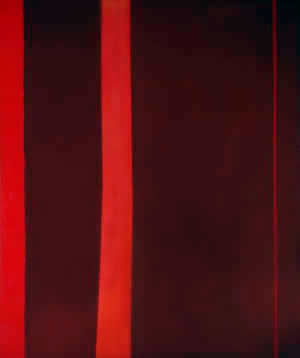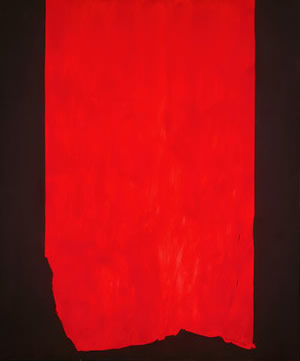|
Barnett
Newman (U.S.A. 1905 - 1970)

Adam 1951-2
Tate Modern, London (purchased 1968)
Oil on canvas 242 x 202 cm
|

Achilles, 1952
National Gallery of Art, Washington D.C.
Oil on canvas 242 x 201 cm |
From the mid-1940s,
Newman had been preoccupied with the Jewish myths of
Creation.
The vertical strips in his paintings may relate to certain
traditions
that present God and man as a single beam of
light.
The name Adam, which in the Old Testament was given to
the fist man,
derives from the Hebrew word adamah (earth),
but is also close to adom (red) and dam (blood).
The relationship
between brown and red in this painting may therefore
symbolise
man's intimacy with the earth. |
|

Vir Heroicus Sublimis
Newman
is one of the principal artists to be associated with the
movement
that came to be known as Abstract Expressionism.
Based in New York his work came to prominence during the
late 1940s and 1950s.
Newman's painting is typically made on a large scale; it
is emphatically abstract, and deceptively simple.
The majority of these works contain one or more vertical
or near vertical lines inscribed within a broad, flatly
painted field of saturated oil or acrylic colour.
The linear elements, or 'zips' are often made by masking
off areas of the canvas with tape, which is then removed
at some point during the painting process.
Thus the zips can appear either to rest on the surface of
the colour plane or lie somewhere behind it.
The
work has been interpreted in a variety of ways.
For some commentators, Newman is a self-referential abstract
practice in which the lines and planes are seen principally
to emphasise the shape and structure of the rectangular
canvas.
However Newman himself aimed to make work in the tradition
of a 'tragic' or 'sublime' art.
The work would have the ambition of the epic schemes of,
say, Michelangelo, but would be made in entirely modern,
that is to say, abstract terms.
The title often provides a clue to Newman's thinking.
Adam is clearly not meant as a likeness in a conventional sense.
The work is perhaps more concerned with abstract concepts such a beginnings, origins and Creation.
Other works of the time have titles such as One and In the Beginning.
For Newman the artist could not adequately illustrate such fundamental ideas through conventional imagery.
Rather his aim was to produce an abstract equivalent for the experience of oneness or beginning.
© The Trustees of The Tate Gallery 2000
|
|
|